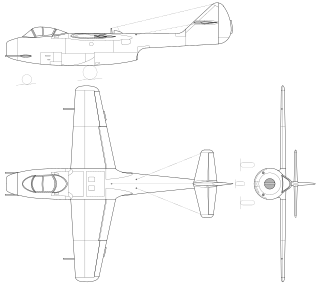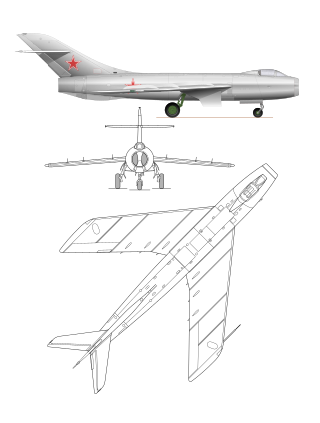See also
Related development
Aircraft of comparable role, configuration, and era
Related lists
| EF 131 | |
|---|---|
| Role | Bomber |
| National origin | USSR |
| Manufacturer | GOZ-1 |
| Designer | Dr. Brunolf Baade |
| First flight | 23 May 1947 |
| Retired | 1948 |
| Status | Cancelled |
| Number built | 1 |
| Developed from | Junkers Ju 287 |
| Variants | OKB-1 140 |
The OKB-1/Junkers EF 131 was a jet bomber produced in Germany and the USSR from 1944. It was cancelled in August 23, 1948, after further work was stopped on the aircraft.
The EF-131 was developed based on fragments of project documentation for the Ju 287 after the Red Army captured the Junkers factory in Dessau. The first prototype was built from components of the Junkers Ju 287 V2 and V3, the second and third prototypes (V – Versuchs – test/research/prototype) of the Luftwaffe's radical forward-swept-wing jet bomber. The V2 was nearly complete before the end of World War 2, but was hidden in the forest at Brandis along with Ju 287 V1 and eventually blown up by the Germans to avoid capture by US forces, and remnants of it, including wing sections, were taken into Red Air Force hands under military intelligence supervision along with the skeletal airframe of the unfinished V3. [1] The V3 was to have been the first 287 to be made to pre-production model specifications, and the eventual EF-131 was almost identical to it in terms of overall design, except in having a slightly longer fuselage. The airplane was completed in the Soviet zone of occupied Germany, but was dismantled and transported to GOZ-1, (Gosudarstvenny Optniy Zavod – state experimental plant), at Dubna near Moscow, because the victorious Allies forbade the construction and testing of aircraft in occupied Germany. OKB-1 at GOZ-1 was formed with Dr. Brunolf Baade as the chief designer, and a very talented team of German engineers seconded by the Soviet government. Extreme pressure was applied to get the aircraft ready to appear in the 1947 Aviation Day fly-past at Tushino airfield, but several factors combined to prevent the EF-131 from appearing. [2]
Flight testing in the USSR began on 23 May 1947, at the LII airfield, after the airframe had been strengthened to meet the requirements of a TsAGI(Tsentralniy Aerodinamicheskiy i Gidrodinamicheskiy Institut- central aerodynamics and hydrodynamics institute) structural survey, which revealed major weaknesses of the airframe. The first flight resulted in the port undercarriage collapsing due to a bolt failure, subsequent flight tests revealed major deficiencies such as nosewheel shimmy and tail surface vibration. Rectification of the defects caused many delays but the worst delays were caused by bureaucracy when it was decreed that foreign workers could not work at the LII airfield. [2]
The aircraft sat at LII over the winter but the harsh conditions caused the deterioration of rubber components and wiring, which required lengthy repairs. Preparations for resuming flight tests were almost complete in June 1948 when Ministry of Aircraft Industry Order No. 440 ordered that further work on the EF-131 be discontinued, termination of the programme being confirmed by resolution No.3206-1301 issued on 23 August 1948. [2]
The EF-131 had become obsolete as newer Soviet-built engines with better performance became available. The airframe of the second prototype was used for the 140 programme. [2]
Data from [2]
General characteristics
Performance
Armament
Related development
Aircraft of comparable role, configuration, and era
Related lists

Junkers Flugzeug- und Motorenwerke AG more commonly Junkers, was a major German aircraft and aircraft engine manufacturer. It was founded in Dessau, Germany, in 1895 by Hugo Junkers, initially manufacturing boilers and radiators. During World War I and following the war, the company became famous for its pioneering all-metal aircraft. During World War II the company produced the German air force's planes, as well as piston and jet aircraft engines, albeit in the absence of its founder who had been removed by the Nazis in 1934.

The Junkers Ju 287 was a multi-engine tactical jet bomber built in Nazi Germany in 1944. It featured a novel forward-swept wing, and the first two prototypes were among the very few jet propelled aircraft ever built with fixed landing gear.
The OKB-1 '140', was a jet bomber produced in the USSR from 1947.

The Yakovlev Yak-36, also known as Izdeliye V, is a Soviet technology demonstrator for a VTOL combat aircraft.

The Sukhoi Su-9 was an early jet fighter built in the Soviet Union shortly after World War II. The design began in 1944 and was intended to use Soviet-designed turbojet engines. The design was heavily influenced by captured German jet fighters and it was subsequently redesigned to use a Soviet copy of a German turbojet. The Su-9 was slower than competing Soviet aircraft and it was cancelled as a result. A modified version with different engines and a revised wing became the Su-11, but this did not enter production either. The Su-13 was a proposal to re-engine the aircraft with Soviet copies of the Rolls-Royce Derwent turbojet as well as to modify it for night fighting, but neither proposal was accepted.

The Yakovlev Yak-15 was a first-generation Soviet turbojet fighter developed by the Yakovlev design bureau (OKB) immediately after World War II. The main fuselage was that of Yakovlev Yak-3 piston-engine fighter modified to mount a reverse-engineered German Junkers Jumo 004 engine. The Yak-15 and the Swedish Saab 21R were the only two jets to be successfully converted from piston-power to enter production. 280 aircraft were built in 1947. Although nominally a fighter, it was mainly used to qualify piston-engine-experienced pilots to fly jets.

The Ilyushin Il-6 was a Soviet long-range bomber developed from the Ilyushin Il-4 during 1942. Originally intended as a high-speed replacement for the Il-4, it was recast as a very long-range bomber with fuel-conserving diesel engines before production of the single prototype began in December 1942. Flight testing showed controllability issues when landing at high weights and the engines proved to be hard to start at low temperatures and were slow to respond to throttle movements. Further development was canceled in 1944.
The EF 132 was a planned jet bomber, under development for the Luftwaffe during World War II. It was the last aircraft project development undertaken by Junkers during the war, and was the culmination of the Ju 287 design started in 1942.

The Yakovlev Yak-25 was a Soviet military aircraft, an early turbojet-powered fighter aircraft designed by the Yakovlev OKB. The designation was later reused for a different interceptor design. Tasked by the Council of Ministers in a directive issued on 11 March 1947, with producing a straight winged fighter similar to the earlier Yak-19, but powered by a Rolls-Royce Derwent V, OKB-115 swiftly produced the Yak-25, which blazed several trails as the first Soviet fighter with a fully pressurised cockpit, air conditioning, jettisonable canopy, and hydraulic airbrakes on the fuselage amongst other innovations.

The Lavochkin La-150, was designed by the Lavochkin design bureau (OKB) in response to a 1945 order to build a single-seat jet fighter using a single German turbojet. By this time both the Americans and British, as well as the Germans, had already flown jet fighters and the single Soviet jet engine under development was not yet ready for production. The design was completed quickly, but the construction of the five flying prototypes was protracted by the factory's inexperience in building metal aircraft. The aircraft made its first flight in September 1946, but proved to require extensive modifications to meet the Soviet Air Forces' requirements. These took so long to make and test that the aircraft was essentially obsolete by the time that they were completed. Even one variant with a much more powerful engine was inferior to other aircraft that the OKB had under development and all work was terminated in 1947.
The Sukhoi Su-10 or Izdeliye Ye was a Soviet turbojet-powered bomber aircraft built shortly after World War II.

The Sukhoi Su-17 was a prototype Soviet fighter. The name was later reused for an entirely different fighter-bomber, see Sukhoi Su-17.

The Ilyushin Il-22, USAF/DOD designation Type 10, was the first Soviet jet-engined bomber to fly. It used four Lyulka TR-1 turbojets carried on short horizontal pylons ahead and below the wing. The engines did not meet their designed thrust ratings and their fuel consumption was higher than planned. These problems meant that the aircraft could not reach its required performance and it was cancelled on 22 September 1947.
The Ilyushin Il-46 was a jet-engined bomber produced in the USSR during 1951-2, as the result of a directive to redesign the Il-42 project. The revised specification was for an aircraft with twice the range and 1 1/2 times the bomb load, with a prototype ready to be submitted for state acceptance trials in July 1952. The Ilyushin design bureau set about designing two versions of the same aircraft, the straight-wing (Il-46) and the swept-wing (Il-46S), with as much as possible common to both aircraft. To meet the schedule for state acceptance trials Ilyushin built only the straight-wing version, fearing that the design, manufacture and flying characteristics of the swept-wing aircraft might cause delays.

The Lavochkin La-160, known as Strelka (Arrow), was the first Soviet swept-winged jet fighter research prototype. It was designed and manufactured by the Lavochkin Design Bureau from 1946. USAF reporting name - Type 6

The OKB-1 150 was a jet bomber designed and produced in the Soviet Union from 1948.

The Tupolev Tu-1 was a prototype Soviet night fighter variant of the Tupolev Tu-2 medium bomber that first flew after the end of World War II. It was cancelled when its experimental Mikulin AM-43V engines reached the end of their service life.
This is a glossary of acronyms and initials used for miscellaneous items, materials and nicknames in the Russian Federation and formerly the USSR. The Latin-alphabet names are phonetic representations of the Cyrillic originals, and variations are inevitable.
This is a glossary of acronyms and initials used for organisations in the Russian Federation and formerly the USSR. The Latin-alphabet names are phonetic representations of the Cyrillic originals, and variations are inevitable.
The Mikoyan-Gurevich I-75 was the final design of a series of three experimental swept-wing interceptors developed in the Soviet Union in the mid-late 1950s by the Mikoyan-Gurevich design bureau from their Mikoyan-Gurevich I-3 airframe. All the aircraft in the I-3 program were affected by delays in the development of the Klimov VK-3 turbojet engine, its cancellation and ultimate replacement by the Lyulka AL-7F turbojet engine.